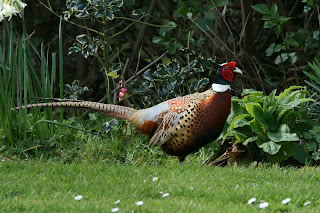After the early rush in March, and great weather to go with it, we have had a very quiet month in April and pretty dismal weather to boot..
This week I managed to squeeze in a bit of fieldwork for the CBS (Countryside Bird Survey) in between the downpours and high winds. I had my first Swift of the season, this morning, flying over the house and heading due North.
On the CBS square, down on the Coast near Killoughter, a Grasshopper Warbler gave its weird but distinctive reeling song, not seen of course! A Sedge Warbler was also in song but the most welcome sight was 4 Stonechats, presumably 2 pairs and 2 fledged juveniles.. After a
near disastrous drop in population in 2009 and particularly in 2010, brought about by hard winters ( 2011 figures are not yet published), it was great to locate them back on familiar haunts with young birds too..
+(John+Fox).jpg) |
| Male Stonechat ( John Fox) |
Back in the garden, the Jays are still in the hunt for scraps and peanuts, in fact they are getting more relaxed and skilled on the feeders.. it will be interesting to see if they bring young birds in, later on in the season.
















